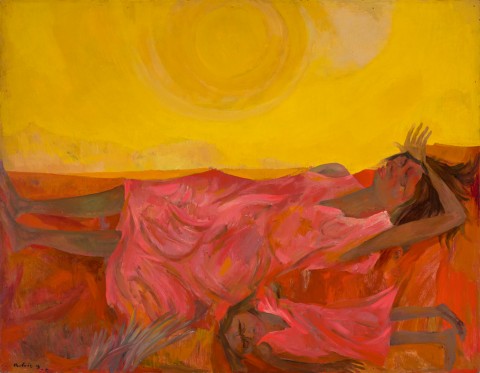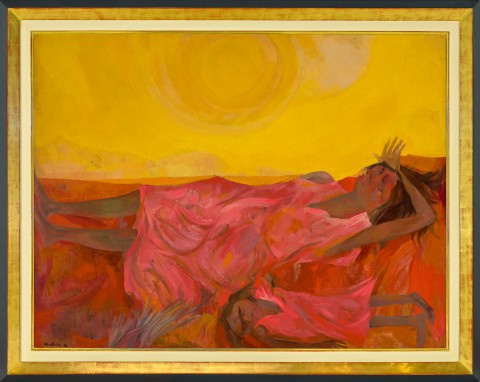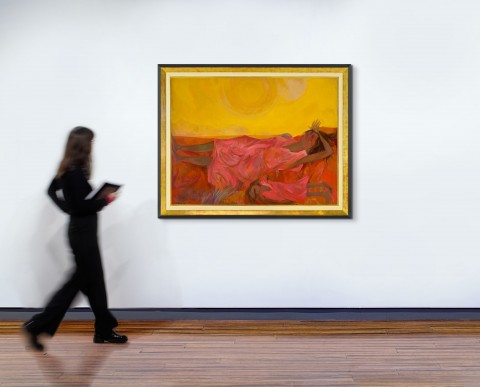SLEEPING ABORIGINAL WOMAN AND CHILD, 1958
JON MOLVIG
enamel and oil on composition board
107.0 x 137.0 cm
signed, dated and inscribed lower left: Molvig 58 / EO
David Jones Art Gallery, Sydney (label attached verso)
Judy Cuppaidge, Brisbane, until 1979
Westpac Art Collection, Sydney
Sotheby’s, Melbourne, 17 April 1989, lot 458 (as ‘Woman and Child’)
Private collection, Melbourne
The Australian Women’s Weekly Art Prize Exhibition, Art Gallery of New South Wales, Sydney, 17 September – 19 October 1958, then touring all state galleries, cat. 20 (as ‘Untitled portrait’)
The Sound of Sky: the Northern Territory in Australian Art, Museum and Art Gallery of the Northern Territory, Darwin, 8 April - 16 July 2006, cat. 89
Churcher, B., Molvig: the lost Antipodean, Allen Lane, Melbourne, 1984, cat. 206 (as ‘Untitled Portrait: Sleeping Aboriginal Woman and Child’), pp. 69, 74 - 75, 77 (illus.), 83, 185
Murray, D., The Sound of Sky: the Northern Territory in Australian Art, Museum and Art Gallery of the Northern Territory, Darwin, 2006, p. 116 (illus.)
The late 1950s were a period when, for a number of non-Indigenous Australian artists, ‘(m)orality … assumed a prominence’ and through their imagery ‘endeavoured to use art to probe contemporary ethical issues.’1 Of these, Arthur Boyd’s ‘Bride’ series and Russell Drysdale’s memorable outback portraits of Aboriginal people are well known, but others who pursued a similar course include James Cant, David Boyd, Ray Crooke and Sam Fullbrook. Another was the Brisbane artist Jon Molvig and Sleeping Aboriginal Woman and Child, 1958, is a powerful and evocative statement where the figures and the parched land almost merge. It was painted in Molvig’s studio in Lambert Street, Kangaroo Point, after the artist had returned from an epic car journey with his former student (and then partner) Maryke Dageus, travelling via Melbourne, Adelaide, Port Augusta and the desert, up to Alice Springs, where they camped for nearly six weeks next to Uluru.2 They then drove back across Queensland to Brisbane.
Molvig was born in Newcastle to a Norwegian sailor who had travelled to Australia on board a windjammer. During World War Two, he served with the Army in New Guinea and the Philippines, enrolling as a student at East Sydney Technical College after he had been discharged. He went overseas in 1949 and studied painting in Europe until 1953. Described as ‘a man who enjoyed pubs, played darts, strummed the guitar, sang bawdy ditties and was an expert with the longbow,’3 Molvig held his first exhibition at Sydney’s Macquarie Galleries in 1955, and the following year, painted a powerful seated self-portrait, depicting himself as if carved from the cliffs bordering the Aswan Dam in Egypt. He was a restless artist and in these years was moving from a dynamic expressionist phase into a more considered approach rich in angularity and vibrant colours, influenced by his close study of artists such as Pierre Bonnard and Ernst Ludwig Kirschner.
Sleeping Aboriginal Woman and Child attracts an extended analysis in Betty Churcher’s authoritative monograph Molvig: the lost Antipodean, from 1984: ‘The anthropomorphic curves and furrows (in this painting) … have been given specific human form, and like the legendary women of the Aboriginal Dreaming, they seem on the very point of metamorphosis, when their bodies will be converted forever into features of the landscape. They could also be a metaphor for the desert: the arid land that stretched out like a baited trap, set with opalescent colour to seduce the eye.4 Churcher also recorded that the letters ‘EO’ which appear next to the signature are the artist’s shorthand for his use of enamel and oil paints in this work.
Molvig’s star began to rise following Sleeping Aboriginal Woman and Child’s inclusion in the 1958 The Australian Women’s Weekly Art Prize Exhibition at the Art Gallery of New South Wales, leading to an invitation to join the stable of artists established by influential Sydney dealer Rudy Komon; though Molvig ‘adamantly refused’ a similar invitation to join the Antipodeans in early 1959.5 Before entering the Westpac Collection, Sleeping Aboriginal Woman and Child was owned by the Cuppaidge family whose patriarch Russell had his portrait painted by Molvig, subsequently entered into the Archibald Prize in 1959. Molvig would go on to win the Archibald Prize 1966 with his portrait of close friend Charles Blackman (Art Gallery of South Australia).
1. Heathcote, C., A quiet revolution: the rise of Australian art 1946-1968, Text Publishing, Melbourne,1995, p. 95
2. See: John Molvig: maverick, exhibition catalogue, Queensland Art Gallery|GOMA, Brisbane, 2019, pp.15, 32
3. McGrath, S., ‘The Viking is on the wall’, The Weekend Australian Magazine, 4-5 November 1978, p. 6
4. Churcher, B., Molvig: the lost Antipodean, Allen Lane, Melbourne, 1984, p. 74
5. Heathcote, C, ibid., p. 114
ANDREW GAYNOR


